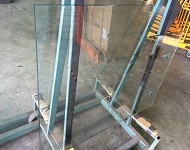Introduction
Laminated glass is commonly known to be used in a building’s windows and in automobile windshields as a safety glass to protect people and property. It is formed by the layering-up (under either heat and/or pressure) of a polymer film between two sheets of glass. It has been a great boon to the glass industry and a beneficial, life-saving development for the public.
Nowadays however, the laminating process is also being used to introduce ‘smart’ or ‘intelligent’ electrically powered films between those sheets of glass. What has driven research into this field of glass lamination is principally ‘energy conservation’ as it applies to architecture and buildings – specifically their cladding.
Interlayer Films
PVB Polyvinyl butyral.
The most familiar, and perhaps earliest film to be used in glass lamination (for more than 60 years), is PVB. It is formed from the reaction of polyvinyl alcohol with butyraldehyde. PVB is, however, very sensitive to moisture which can cause difficulties with both the processing and storage of the product.
EVA Ethylene-vinyl acetate.
This is the co-polymer of ethylene and vinyl acetate. ‘Architectural’ EVA film is used in Vertical Safety Glass, Sloped Safety Glass and Overhead Safety Glass. It is used in glass lamination because of its high-performance and functional safety properties. It also has reliable, long-time weather resistance properties and better light transmission than PVB. ‘Solar’ EVA film, a heavier-duty version, is used in Solar Panel encapsulation.
TPU Thermoplastic polyurethane.
This technical, optical aliphatic film interlayer can bond glass together to create tough, high-quality glass that won’t discolour or degrade over time. It permits outstanding clarity, low haze and good light transmission.
It also enables low laminating temperatures and is fully compatible with polycarbonate (for high-speed and armoured vehicle windscreens), enabling superior levels of adhesion and the ability to bond dissimilar substrates. TPU film is resistant to UV degradation and retains good stability in humid conditions and at temperature extremes thanks to its ability to compensate for thermal expansion and contraction.
Each of the above polymers has its uses and scientists are constantly working to improve, or add to their properties. This takes us to Part II and the field of ‘intelligent interlayers’.

